Happily Ever After, American Style
I’m not sure you could make The Little Mermaid nowadays. Ariel is only sixteen years old; basically a child. And not even a very mature child—her best friend is Flounder, who’s clearly even younger than she is (he must be like 13). She runs away from home to be with a stranger who she has a crush on. And at the end of the movie, her dad actually gives permission for them to marry. (I mean, aren’t they going to even date for a while? She’s sixteen.)
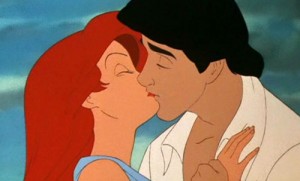
Statutory rape.
Personally, I don’t have a problem with The Little Mermaid. It’s just a fairy tale, and it’s set at a time when sixteen was a totally appropriate age to get hitched. But my point is, The Little Mermaid is arguably the least feminist Disney animated film of the bunch. Just think about the climax, when the heroine flops around helplessly on a rock, while her brave prince rescues her with a pointy boat.
But as we said before, Pocahontas and Mulan are clearly the two most proactive princesses, and the two least popular. Maybe the more feminist you make the Disney film, the less little girls like it. However, correlation doesn’t equal causation. Maybe those two are less popular because they don’t wear the frilly dresses girls love. Maybe it’s because they aren’t technically princesses. Maybe little girls are filthy racists.
In any case, The Princess and the Frog is clearly doing a tricky square dance: how do you tell a story with a strong female role model, while still delivering enough princessy stuff to satisfy all those little girls? Is that even possible?
First of all, Disney left no doubt that Tiana becomes an actual princess. The love interest, Prince Naveen, really is the Prince of “Maldonia,” a fictional country where they have sexy Latin accents. But the filmmakers work really hard to demolish the idea that being royalty is inherently awesome. Prince Naveen is broke, cut off by his parents. He’s visiting New Orleans partially to marry a rich woman, so he can continue his life of sloth. But there’s a critical scene halfway through the film where Naveen tells Tiana about how he used to have servants brush his teeth for him:
Hey, I admit, it was a charmed life. Until the day my parents cut me off. And suddenly I realized I don’t know how to do anything.
He says this with a genuinely embarrassed, sad tone. For a movie that’s aimed right at the hearts of millions of princess-obsessed little girls, this is a rather remarkable statement: being royalty and living in a castle isn’t so great after all.
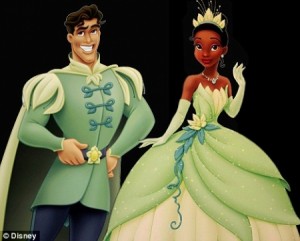
This does NOT actually happen.
Think about the long list of Disney movies that end with the happy couple moving into a castle. This movie is the complete opposite—the Prince happily puts aside his life of royalty to live in the her world. In the final musical montage, we see the two of them buy the dilapidated old building, and painstakingly fix it up. They open the restaurant she’s always dreamed of, and call it… wait for it… “Tiana’s Palace.”
The movie has its gumbo, and eats it too. Yes, Tiana marries a prince and becomes a princess. But she doesn’t seem to care that he’s a prince at all; there’s no indication they even visit his country. Instead, she builds her own palace. This is like if at the end of Coming to America, Eddie Murphy decided to stay in Queens and help Lisa open a whole chain of McDowell’s restaurants.
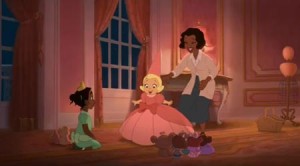 This is the first Disney princess movie since the creation of the Disney Princess brand in 2001, and it’s clear they have mixed feelings about the monster they’ve created. Tiana’s friend Charlotte is a rich white girl, absolutely smitten with all things princess. In fact, the reason they become friends is because Tiana’s mom is a seamstress, and Charlotte demands a huge collection of frilly princess dresses. When Prince Naveen comes to town, Charlotte is obsessed with marrying him, sight unseen, simply because he’s a prince. Becoming a princess is her one ambition in life… just because. Charlotte is a funny character, but she’s also a pretty biting caricaturization of this movie’s core audience. Her princess obsession, contrasted with Tiana’s complete disinterest, feels like a gentle rebuke to the girls who bring their own tiaras to the multiplex. I actually saw these people.
This is the first Disney princess movie since the creation of the Disney Princess brand in 2001, and it’s clear they have mixed feelings about the monster they’ve created. Tiana’s friend Charlotte is a rich white girl, absolutely smitten with all things princess. In fact, the reason they become friends is because Tiana’s mom is a seamstress, and Charlotte demands a huge collection of frilly princess dresses. When Prince Naveen comes to town, Charlotte is obsessed with marrying him, sight unseen, simply because he’s a prince. Becoming a princess is her one ambition in life… just because. Charlotte is a funny character, but she’s also a pretty biting caricaturization of this movie’s core audience. Her princess obsession, contrasted with Tiana’s complete disinterest, feels like a gentle rebuke to the girls who bring their own tiaras to the multiplex. I actually saw these people.
But of course, it’s a VERY gentle rebuke. Because even though this movie thumbs its nose at the traditional idea of princesses, it’s also very much a part of that Disney Princess brand. Visit the DP website (if you dare!) and you’ll see Tiana front and center.
There’s one early scene that sums up this conflict completely. Tiana attends Charlotte’s masquerade ball, and falls into a table of food. Charlotte, who for all her ditziness is a good friend, offer her a change of clothes. And that’s how Tiana ends up in her gorgeous princess dress. It’s not her dress at all. It’s a costume, and it’s somebody else’s costume.
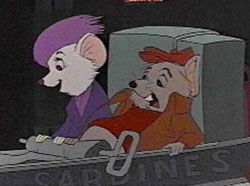
Bob Newhart was providing his famous voice for cartoons before it was cool.
That’s it for my chart, but I have a couple more points.
An Animated Movie WITHOUT Will Arnett??
It’s become par for the course to stock your children’s animated films with famous voices, usually comedians. Before The Princess and the Frog, there was a trailer for Despicable Me, which prominently featured a big list of names: Steve Carell, Jason Segel, Will Arnett, Danny McBride, Russell Brand, Jermaine Clement, Mindy Kaling, Jack McBrayer, etc etc. This is a sneaky way of getting parents onboard. Madagascar had Ben Stiller, Chris Rock, David Schwimmer, and Sacha Baron-Cohen. Kung Fu Panda had Jack Black, Dustin Hoffman, Angelina Jolie, Seth Rogen, and for HBO-loving parents, Deadwood’s Ian McShane.
It’s easy to forget that animated films didn’t used to lean on big names like this. The only recognizable voice in The Little Mermaid was Buddy Hackett as the seagull. Beauty and the Beast had unknowns in the major roles, but then tossed in Angela Landbury and Jerry Orbach (Did you guys not know that the singing candlestick was the gruff Law & Order detective? Surprise!). But I think it was Aladdin that changed things. Robin Williams didn’t merely play a role–he brought his own comic persona to the role, in a way all the adults would recognize. And Williams’ presence in the movie was publicized to great success. (Aladdin made way more than any animated film in history at that point.) The lesson Hollywood learned from this is that star power can sell animated movies, in the same way that it can sell other movies.
But in recent years, you could see Pixar trying to wean itself off celebrity voice talent. Cars had Owen Wilson, Paul Newman, Larry the Cable Guy, etc. But for Ratatouille, the main role of the chef who befriends a rat was actually voiced by a Pixar staffer named Lou Romano. Wall-E’s main characters didn’t even have voices.
And with the Pixar folks taking over all of Disney animation, maybe it’s not surprising that they didn’t want to anchor The Princess and the Frog with A-List talent. According to IMDB, Jennifer Hudson, Alicia Keys, and Tyra Banks all pushed hard for the lead role. Instead, it went to a relative unknown. Maybe it was because the relative unknown was head-and-shoulders above the rest. Or maybe it was because the studio didn’t want a recognizable voice that would overshadow the rest of the production. Ditto Prince Naveen—it’s a great comic role, and I’m sure they could have found a famous comedian to ham it up. Instead they picked Bruno Campos, who seems to have spent the past ten years doing TV. He’s great in this. And I’ve got to say, it’s a pleasure not to recognize the voices and just enjoy the movie. I was a little annoyed when John Goodman sailed in, doing his Oh Brother, Where Art Thou southern accent.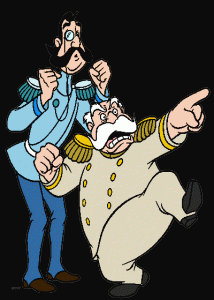
Revenge of the English-Accented Majordomo
It is a time-honored Disney tradition that all princes must have a royal sidekick. This person must be perpetually frazzled by the headstrong prince, and subjected to constant physical abuse. More importantly, this person must have an English accent, regardless of what nationality the prince is supposed to be.
This tradition probably started with Cinderella. In that movie, the Prince himself kept largely offscreen. But the King was always attended by the Grand Duke, a priggish monocled fellow who lived in constant fear of his master’s wrath. And with good cause—in one scene I used to rewatch constantly, the old man chases the Duke around with a sword.
No manservants in Sleeping Beauty, but The Little Mermaid brought us Grimsby. Like the Grand Duke, Grimsby was a guy whose dignity was imperiled in pretty much every scene. The first time we see him, he’s vomiting off the side of a boat. In Beauty and the Beast, Cogsworth played the same role. In The Lion King, it was Zazu. All these characters are fiercely loyal, but their pompous self-regard makes them irresistible targets. Call them the Disney Malvolios.
 Prince Naveen has Lawrence, who at first seems to be the perfect stereotype. He’s English-accented, comically fat and mutton-chopped, and constantly humiliated by the Prince. Because he fits the part, we expect the guy to be doggedly loyal comic relief. The twist is, Lawrence is actually villainous comic relief.
Prince Naveen has Lawrence, who at first seems to be the perfect stereotype. He’s English-accented, comically fat and mutton-chopped, and constantly humiliated by the Prince. Because he fits the part, we expect the guy to be doggedly loyal comic relief. The twist is, Lawrence is actually villainous comic relief.
The switcheroo is pulled off nicely. We see Naveen and Lawrence tied up and helpless as the witch doctor, Doctor Facilier, casts some sort of evil and highly musical spell. Soon after, a strangely different Prince Naveen shows up at a party. Naturally, we assume it’s Facilier. But in a later scene, we find out it’s Lawrence, who’s working with Facilier as payback for a lifetime of abuse. It’s a clever little twist that harkens all the way back to the Grand Duke dodging that sword.
(There is one other Disney movie in which the royal sidekick betrays his boss: Aladdin. But I’d argue that’s different. We know Jafar is the villain before we know he works for the sultan. Besides, Jafar doesn’t fit the Disney Malvolio stereotype.)
They Are Not Afraid to Make Little Kids Cry
Finally, I have to mention the most surprising part of The Princess and the Frog. Remember that hilarious cajan firefly from the teaser trailer?
http://www.youtube.com/watch?v=o0j7EactM9s#t=0m38s
Yeah, he dies. No, he doesn’t come back to life. He takes on a herd of ghosts in a cemetery, and the evil Facilier steps on him. He lives long enough to say goodbye to his friends, and then his light slowly fades. And I may be wrong about this, but I don’t think I’ve ever seen a Disney movie with an actual funeral.
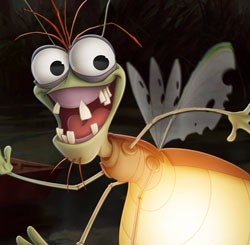
If it makes you feel any better, his life-expectancy was probably about five days.
I was definitely caught off-guard by this. It seems perverse to try and sell stuffed animals of this critter to kids, and then kill him off. But I like it. It smacks of Pixar to me–those guys are convinced that children’s entertainment shouldn’t be sanitized of all of life’s unpleasant realities. And the funeral is actually really well done. All the fireflies put him on a leaf, and float him into the mist of the bayou. It’s sad. Real sad, but in a good way. The Princess and the Frog is clearly a more commercial exercise than the Pixar stuff, but it’s still got heart. And balls.
In case you couldn’t tell after 3,000 words, I like this movie a lot. I think the question you have to ask about any Disney animated film is, “Would I mind being subjected to this on DVD about 50 times?” I think by the 40th time, I’m going to relish that firefly’s death scene, but all children’s entertainment should be this good.
Sadly, America seems fairly meh towards Princess. The movie grossed about $25 million in its opening weekend. Which is… fine. But considering the marketing blitz, it’s probably a little less magical than they were hoping for. On the bright side, the movie got mostly glowing reviews, and if it counts for anything, I’m still humming the songs. If the Disney people can keep that kind of quality up, I’m looking forward to adding new rows to my chart.
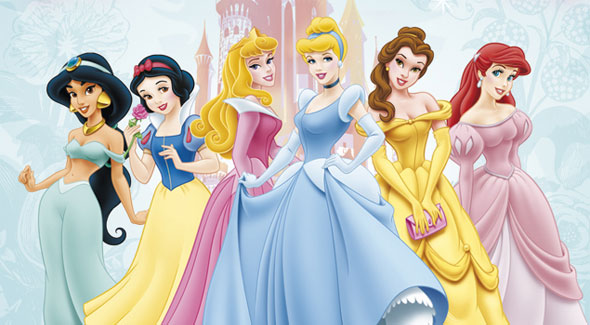
You forgot Lady & the Tramp
= Lady led a pampered life until her walk on the wild side
+ HEA with puppies
+ Tramp would fit into the empty slot on the Human/Dog chart
= Tramp eats human pasta and scraps, but lived in the streets as a stray, all the other dogs on that list have owners, Tramp did not.
Snow White and cindarella both have their Dads. Show Whites dad took her to the forest to kill her and cinderellas dad marryed again at the start.
This is a great article.
@Emilia – Sorry, but wrong. The Queen doesn’t send the King to kill Snow White. That’s her “huntsman.” (I assume this was a real profession at some point.) And Cinderella’s dad dies in the first 60 seconds. The whole POINT of the film is that she’s an orphan, at the mercy of her evil stepmother.
@Jon Eric – Thanks!
Oprah was Tiana’s mom. And Emeril Lagassi was the alligator that tried to eat them. I only knew that because I watched a special on it the day before it was out, though- I would have thought Oprah sounded familiar but not placed her, and I wouldn’t have noticed Emeril. But there is no way in heck I’d miss Keith David. His voice is impossible to NOT recognize. I nominate him as another of your muses, actually- he’s everywhere and made of awesome no matter if he’s turning to stone by day or fighting off volcanoes in L.A. by night.
I was shocked at Ray’s death, too, and I don’t think I can recall an actual funeral in a Disney movie, either. That was the first death of a major good-team character in a Disney movie I can think of. And by that I mean one there for the main part of the plot- I don’t count Mufasa because the plot of _The Lion King_ revolves around and depends on what happened to him and how. Shang’s dad in Mulan gets killed, but there isn’t much contemplation of that, and we barely see him in the movie. Anyhoo, my point is that was the first thing I said when the credits were over, “I can’t believe Ray actually DIED.” But two things. First, the funeral sequence was absolutely exquisitely drawn and depicted. It had this fluidity to it that made it almost like a dream, sad as it was. Which leads to the second point, that another star shows up next to Evangeline.* However cheesy it was, that actually did help ease my heart a bit. And whether it actually happened in the world of the movie makes no difference, too- the affect would have been there, regardless.
I think Disney achieved exactly what they wanted, which was to create an AMERICAN fairy tale. Tiana was pro-active not only in a feminist sense, but in alliance with the American dream of making your own fortune. To use the language of the movie, she made her own magic and miracles. While Naveen’s parents are shown happy for him at their wedding, his decision to stay with her and help her live HER dream seems to me as though it’s alluding to how from “all around the world, they’re coming to America,” so to speak. Our dream is much better than those old, stuffy European ones, and he chooses America with the blessings of his parents, the rulers of their own kingdom. It’s much more satisfying to earn what you’ve got instead of having it handed to you by servants, according to the message given throughout the movie. The cynic in me wants to speculate about whether his parents helped them buy the building or not once he told them his intentions, but the majority of me that loved the movie so much just beats the cynic into submission. I’d much rather see it as it’s surface-level portrayed. I also think it’s pretty significant that her dad dies in WWI- a poor black man dying in the Army while troops were still segregated, yet his daughter is close friends with the riches white girl in the city. Meant to prove how individually, Americans are Good People and Do The Right Thing, maybe? Why not?!
One small bit: I know some people were still angry about a lot of things in it because of racism, but I haven’t been able to find any moral outrage because of the frog hunters. They were pretty stereotypical “poor white trash” or “hillbilly” or something of that nature. At the very least, they seemed like a borderline, if not outright classist portrayal.
*Is this a reference to the Longfellow poem, or is it going for the meaning, “bearer of good news”? I dunno, but it’s worth thinking about… Ahem…
Regarding the “Revenge of the English-Accented Majordomo,” this was actually done earlier in the mostly-not-animated “Enchanted.” (Which I finally just sat down to watch.) It might not be quite the same, as it’s established pretty early that he’s in cahoots with the evil queen.
Great article, loved the movie, quite funny
I think you should remember that Bambi’s mother was killed very prominently, and that affected kids greatly. Disney hasn’t ever been one to hide all sadness from kids. Do you remember Dumbo? Remember when his mother is in jail and Dumbo can only visit with her trunk, and that ‘Baby of Mine’ song plays? Talk about some little kid heart-wrenching going on. Also, Fox & the Hound- sad.
It was an awesome article, and I loved the movie! Seen it twice already.
There are just some comments I wanted to make about the article:
1. The lack of moms in Disney movies really has nothing to do with Walt Disney. In the fairy tales these films are based on, the protagonist didn’t have a mother to begin with.
2. You are right about the Disney princess and doing something to make their dreams a reality. I do think Ariel actually tried to make her dream come true by going to Ursula, but that really wasn’t a positive thing to do. I’ve always hated how Belle wanted to have adventure in the great-wide somewhere, but ended up crying when she got her wish. True, she was held against her will, but she was in an Enchanted Castle for heaven’s sake! Haha
3. Ariel is 16, and like you stated, 16 was an appropriate age for girls to marry centuries ago. In the original fairy tale, the mermaid was 15. Aurora was also 16 and Snow White is rumored to be around 14. Yikes! I’m not sure if Tiana is the eldest Princess at 19 though. Anyway, we really don’t know how much time passes between Triton turning Ariel into a human and Ariel marrying Erin. In that time, I’m sure they got to know each other and truly fell in love. People also mention the fact that Ariel gives up everything — voice, family, friends — to be with a man she didn’t know and that he saved her at the end. What people fail to remember is Ariel actually did save Eric in the beginning of the film. I see the climax as Eric sort of saying “Thank You for saving my own life earlier”. I do love how Tiana defeated Dr. Facilier on her own!!!
4. I was very confused about the endind of the movie. Do you really think they stayed in new Orleans forever? I mean, when Naveen’s father dies, who will rule Maledonia? That’s the question I left the movie wondering. Oh, and Coming To America ended with Akeem and Lisa staying in Zamunda.
5. I’m glad I couldn’t recognize the voices of Eudora, Tiana’s Dad, and Big Daddy. If I didn’t know going in, I wouldn’t have know those roles were voiced by Oprah, Terrance Howard, and John Goodman.
All in all, i loved your article and the analysis. I look forward to reading an analysis of Rapunzel next year if you do one. I’ll surely be getting Princess and the Frog when it comes out on DVD.
I loved this article.
Except Mulan shouldn’t even be on the chart as she is NOT a princess. Hers is not even a princess story. I think they just brand her as a princess because she’s a girl, and girl = princess, and they have no other conception of how to market her. Badass warrior doesn’t have the same ring to it, I guess.
I’ve been traveling for a bit, and I apologize for not responding to the comments right away. But there are some great points here, so better late than never:
@Gab – First of all, a big hell yeah re: Keith David. The man took part in what is probably the greatest fistfight of all time in They Live. He also played a pivotal role in one of my all-time guilty pleasures, The Chronicles of Riddick. And as Pete is fond of saying, we at OverthinkingIt love actors who get steady work. Keith David is right up there with J.K. Simmons as a guy that shows up in a lot of things you already like and makes them better.
I’m totally with you about the funeral scene too: it’s a beautiful thing that sticks with me weeks later. And the appearing star was really well done – I admire that way that if you WANT, you can view it religiously (“Ray’s in heaven now”). But only if you WANT – it’s a spiritual moment that works almost regardless of your personal views on death (unless you are a cold, cynical humbug).
Little aside: my four-year-old didn’t cry during that scene, or react in any big way. But a few days later, after I put him to bed, he called me back to his room. “Daddy,” he said after a moment, “no one will die, right?” Which is a tricky question to answer of course, but it was a conversation I was happy to have. I think kids stories, when they’re well-done, should teach something about the way the world works. They can take very abstract concepts, like death, and give the kid a sense of what that means.
Anyway, your point about this being a very American story is dead on. Really it’s a complete REJECTION of princessness… which is why it’s so interesting that it’s being sold as a princess movie.
The frog hunters were pretty broad stereotypes, but I’m fine with stereotyping rednecks. I was strongly reminded of another Disney movie, Pete’s Dragon, which also features a bunch of dumb country hicks. And wow, do I vaguely recall that they made a Country Bears movie? Who the hell greenlit that one?
It is interesting how the movie sort of pussyfoots around the issue of racism. The closest they come is when the white real estate brokers don’t want to give Tiana the property, but you can see that as SEXISM, or maybe just reluctance to deal with someone who makes their down payment in coffee tins of nickels. I’m not really criticizing the Disney people for not showing how racist America used to be, but one might accuse them of whitewashing the past. In my book, they took on a tricky assignment and did it better than anyone expected – you can quibble about the details, but this is definitely a Win.
@Lisa – Yes, very good catch about Enchanted! Actually, it’s VERY similar, right? Much-abused fat guy ineptly betrays his dim-witted master. Only difference is, I don’t think Lawrence wants to have sex with Dr. Facillier.
@Katie – I think the OLD Disney stuff used to be a little more upfront with death and sadness. Bambi’s the prime example. But for purposes of this article, I was really just looking at the PRINCESS movies, which tend to kill off only the villains.
Hmm. Interesting that Bambi and Dumbo are about little BOYS, and they’re more traumatic. The GIRL movies are kinder and gentler.
@Ken – That’s an interesting observation about Belle. At first, her fairy tale seems like a nightmare version of those books she’s obsessed with. The point seems to be, be careful what you wish for, and marry Gaston when you have the chance.
Hmm. Okay, you might have a point about the gap between Ariel getting permanent legs and the wedding scene. MONTHS could have gone by. Personally, I think it’s more like days, but you never know.
And yeah, Ariel does save Eric, and he repays the favor. So it’s not quite as sexist as I made it seem. I’m still not a fan of the “get him to fall in love with you without actually speaking to him part.” I know that’s the fairy tale, but it’s kind of the worst possible message to send to young girls. Still, let me make something clear: I love the movie, and I wouldn’t change a thing.
I think Princess and the Frog made it pretty clear their story ends in New Orleans… for now. I would not be at all surprised if they are currently working on a direct-to-DVD movie about what happens when they go visit Maledonia. Wait, did I just describe the plot of Shrek 2? Anyway Ken, keep in mind that Naveen may have a bunch of siblings – just because he’s a prince doesn’t mean he’s in line for the throne.
And my point was that Coming To America is the exact opposite of Princess and the Frog. In CTA, they go to his country and live in a palace. In PATF, they stay in America and build a life together through elbow grease.
Finally…
@Akilah – Yeah, I’m totally with you. Mulan is not a princess, no way, no how. That’s just a fact. Except that she’s part of this Disney Princess brand, so I included her on the chart. Mulan is a great example of how difficult it is to make movies for little girls. They told a great story about a strong female who saves her entire country. But to make money off of it, they have to force her to wear pretty dresses and call her a princess for no reason. If no one’s written a book about the conception of princesses in America, someone should get on that.
I think Mulan’s mother was dead, actually.
@Ken: I have to defend Belle here a bit, if only because she’s mah favorite. When she cries at the castle, she doesn’t yet know it’s enchanted. And when she flees, it’s out of fear because the Beast goes kuh-ray-zay on her. Neither is out of boredom.
But now this makes me question how awesome she is, since it’s easily argued she, in fact, GIVES UP her dream when she marries the Beast(sansfur). Unless the whole ordeal IS the “adventure,” but a castle is HARDLY a “great, wide somewhere.” And there is nothing to demonstrate he does understand she wants so much more than they’ve got planned, since we have no indication she ever leaves the castle once they’re hitched. That makes me sad.
Saeg: No, she’s very much alive. She sings and gets Mulan “ready,” even:
http://www.youtube.com/watch?v=Qe3Y-nXHsFI
I’d argue Mulan has MORE family than the typical Disney character (excluding the dalmatians and the Darlings)- living, at least, she has two generations above hers in her household; and if you want to get REALLY crazy with it, she’s got a whole shrine-full of dead ancestors. (That’s off the top of my hypedoncoffee brain, though- there is probably somebody else with more family than that somewhere- I just can’t think of any at the moment.)
Loved the article. I can remember watching the old Disney princess movies over and over when I was little on VHS(!) and have even played around with the idea of getting them on DVD even though I know it’s an obvious play to milk the Disney Princess cash cow for all its worth.
Also, in ‘Beauty and the Beast’ Cogsworth was voiced by David Odgen Stiers who played Major Charles Winchester on MASH (and according to his IMDB profile he was also the narrator)
@anybody that cares (since I’m a well of useless information and notice crap like this when watching movies):
David Ogden Stiers was also Wiggins *and* General Ratcliffe in _Pocahontas_. He has kept up that role of Cogsworth in a bunch of other things for Disney (games, specials, etc.), and he has also narrated a number of Pooh-related things for them.
(Hahaha, read that last clause aloud… I need to grow up.)